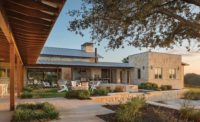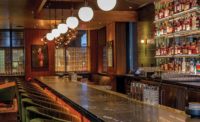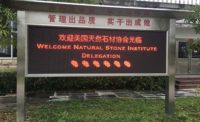Across the Caribbean, architects and developers are moving away from the traditional and locally quarried stone materials they have used in the past. Instead, they are taking advantage of the increasing competitiveness and global availability of much higher-grade stone materials. These look similar, but offer far greater performance, durability and many years of far easier maintenance.
The key measurement for stone performance in tropical conditions is absorbency. Stone that sucks in moisture, salt and airborne microparticles is almost certain to be showing extensive mildew and similar staining within months of being installed.
The iconic Little Dix Bay Resort in the British Virgin Islands recently chose to renovate parts of their property with Italian limestone paving, a major departure from the traditional Coral Stone seen across much of the property and used widely around the Caribbean. The choice to upgrade to a far harder and less absorbent stone was driven by the considerable damage caused by Hurricane Irma in 2018. Five days of continuous rains and submersion by high tides left the existing Coral Stone paving saturated to the point that it was already starting to visibly corrode.
Coral Stone, frequently quarried in the Dominican Republic, has always been available, affordable and logistically feasible for Caribbean projects. Its pitted surface is good around pools and the light colors are desirable under any hot sun. Many people also like the patina of aging that rapidly occurs. But, it has an absorbency rate (ASTM Test C642-97) of anywhere up to 12%.
Coccilato limestone from Puglia, Italy, which was supplied by Groundfloor LLC, that was installed as paving at the Little Dix Bay Resort has an absorbency of less than 0.5%. This ensures anything from normal moisture to extreme hurricane levels of saturation will have a negligible effect on the stone. As important, from a maintenance point of view, this stone will be looking good for the next few hundred years and still enable the facilities department to clean it with minimal effort.
“The Italian limestone is an obvious upgrade to the previous stone,” said Andres Pade, managing director of Little Dix Bay. “It’s also a sound investment due to the stone’s durability and far lower maintenance costs.”
Crucially, the growing ease of shipping into the Caribbean makes superior stone available and affordable. Until relatively recently, most building materials, whether originating in the Caribbean or from around the world, were required to route via Miami, FL. However, increasingly efficient container ports in Jamaica, Puerto Rico and other areas now make shipping directly from Europe or Brazil to British Virgin Islands or elsewhere around the islands highly efficient and considerably less expensive.
“This is a game changer for regional design,” said Marvin Flax, managing director of OBMI Architects in the British Virgin Islands. “Clients have been demanding better value and better durability of stone materials. Also, customized sizes and top-class cutting helps minimize onsite masonry requirements and makes construction easier.”
The same trend to upgraded stone can be seen across the Caribbean. For example, the new Cricket Square 5 building in The Cayman Islands elected to use a superior White Smoke limestone, also from Groundfloor, for flooring and for honeycomb-backed interior cladding panels in elevator lobbies.
“There is a very limited choice of materials available on the island at the quality level the clients and I were looking for, and not much more at retail in Miami, where our local designers traditionally look to,” said Laura Adams, interior architect at Chalmers Gibbs in Grand Cayman. “Being able to easily order and import a high-quality stone, processed to international standards and cut at a factory to the exact custom sizes and formats I needed, enabled us to produce a far superior end product for our clients on a fairly tight budget.”
Not only do the high-quality stone finishes help Cricket Square 5 attract tenants, but they are now actively cutting maintenance costs for building management.
The same trend towards upgrading stone materials is also occurring in the residential market. The recently built Hesperides Villain Turks & Caicos by Coast Architects and Olympic Construction extensively used a low-porosity and high compressive strength Revere limestone for interiors, custom-cut stair treads and pool decking. As a popular luxury rental property, the high-quality stone will enable local management to maintain the property in top condition despite the extensive rental use.









